SPRINGFIELD, Mo. — Beets are available locally and fresh from June to October, and can be found in the grocer all year long according to Dr. Pam Duitsman, nutrition and health specialist with the University of Missouri Extension.
“This vegetable has an especially sweet taste when roasted because the naturally occurring sugars in the beet become concentrated. Beets are also available canned, and are popular as a pickled product,” said Duitsman.
Appearance
When selecting fresh beets, look for smooth, firm skin. Choose small to medium sized beets as they will have the most flavor and be the most tender.
Not all beets are red. Beets come in a range of colors and sizes from red, white, golden and yellow to candy-cane-striped Chioggia, and baby beets.
“I recommend buying beets with the greens still attached. The greens should be crisp and bright green with red veins running through them. Avoid beets that are so dark they almost look black, or if they have rough, pock-marked skin,” said Duitsman.
Nutrition
Beets can be stored unwashed in the refrigerator where they will keep for up to three weeks. Both the beets and their greens will last longer if, before storage, you cut the majority of the greens from the beet, leaving about two inches of the stem attached.
The greens should be stored in a separate container or plastic bag where they will keep fresh for about four days. The greens work very well in salads.
“Both beets and beet greens are very nutritious. Some beet varieties were developed just for growing greens. The greens of beets contain many phytonutrients including carotenoids and flavonoid antioxidants, and they are an excellent source of vitamin A,” said Duitsman.
The deep red color of red beets comes from anthocyanins, which are phytonutrients which have been shown to protect against damage from carcinogens and may help prevent heart disease.
“Beets are rich in antioxidants, which are important for their cancer-fighting and health-promoting properties. Beets also contain high amounts of fiber, which can help maintain a healthy body weight and promote digestive health. Folate is another component of beets. Folate is important for DNA synthesis within our cells, for cell growth and metabolism, and especially for pregnant women,” said Duitsman.
Cooking beets
Beets can be prepared in a variety of ways including raw, boiled and roasted. Scrub well before cooking, but leave an inch or so of the green tops attached.
To boil: Rinse, but do not remove the tops or the roots at the bottom. Add approximately two pounds of beets into a 4 to 5-quart pan with enough water to cover. Cook 20 – 40 minutes or until tender when pierced with a fork. Let cool a bit then hold under running water. Skins should slip off along with the tops and roots.
To roast: Individual whole beets can be wrapped in foil (leaving stem and roots attached). Roast at 400 degrees in the oven for 45 minutes to 1 one-half hours, depending on size.
Quick roast: Scrub, but do not peel beets. Slice into one-half inch pieces; toss with extra virgin olive oil, salt and pepper. Spread single layer on baking sheet. Roast at 400-450 degrees for 20 minutes or until tender.
















